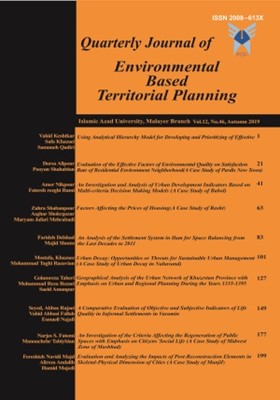Evaluation and Analyzing the Impacts of Post-Reconstruction Elements in Skeletal-Physical Dimension of Cities (A Case Study of Manjil)
Subject Areas :
Fereshteh Navidi Majd
1
,
Alireza Andalib
2
*
,
hamid majedi
3
1 - Ph.D Candidate of Urban planning, Department of urban planning, faculty of Art and Architecture, Science and Research Branch, Islamic Azad University ,Tehran, Iran
2 - Associate professor, Department of urban planning, faculty of Art and Architecture, Science and Research Branch, Islamic Azad University, Tehran, Iran
3 - Full Professor, Department of urban planning, faculty of Art and Architecture, Science and Research Branch, Islamic Azad University, Tehran, Iran
Received: 2017-07-30
Accepted : 2018-02-27
Published : 2019-11-22
Keywords:
disaster,
reconstruction,
Manjil,
physical-skeletal dimension,
Abstract :
One of the important issues in the event of natural disasters in cities is the reconstruction of cities after these accidents. In the process of post-traumatic reconstruction, elements and factors are influential and the set of these processes has several effects on different dimensions of urban development, especially physical-physical dimension. Manjil is one of the cities of Roudbar, Gilan province, which was severely damaged by an earthquake in 1369. The process of rebuilding the city after the accident has had many effects on the physical and physical aspects of the city. In this study, the effects of elements of post-traumatic reconstruction on this dimension and the impact of physical-physical indicators of these elements have been studied. To this end, the effects of these elements and indicators were evaluated through a questionnaire by 25 relevant experts and analyzed by nonparametric binomial statistical test as well as statistical indices. The results showed that the impact of post traumatic reconstruction elements on the physical and physical dimension of Manjil was high and the physical and physical indices of these elements were high too. Also, most of the effects of the reconstruction elements on indigenous, entrepreneurial, and facultative factors were physical and physical indices, as well as building resistance, passageways and access to services had the most impact on the post-traumatic reconstruction process.
References:
سرتیپی پور، م.، هاشمیان، ع.س.، حسینی، م. 1394. تبیین الزامات بازسازی پس از سانحه برسیاست جابهجایی در سکونتگاههای روستایی (نمونه موردی: روستای اسطلخکوه). مجله مسکن و محیط روستا، 151: 18-3.
پاشاپور،ح.،قربانی،ر.،فرهادی،ا.،درودی نیا،ع.1398.پهنهبندی خطر زلزله با استفاده از سیستم اطلاعات جغرافیایی مطالعه موردی کلان شهر تبریز. فصل نامه آمایش محیط، 45(12):69-49.
فتوحی،ص.،کیانی،س.1394. ریزپهنه بندی ریسک سیلاب شهری با استفاده از مدل تحلیل سلسله مراتبی مطالعه موردی شهر نهاوند. فصل نامه آمایش محیط،29(8):152-133.
رحمتی،ص.،گندمکار،ا.،خوشکلام پور،ا.1393. ارزیابی متغیرهای تأثیر گذار بر آسیبپذیری مساکن شهری در برابر زلزله مطالعه موردی: شهر بروجرد. فصل نامه آمایش محیط،24(7):103-83.
فراهانی، ح.،خوشرفتار، ر.، حاجیپور، م.1392. ارزیابی فرآیند مشارکت مردم در بازسازی سکونتگاههای زلزله زده(مطالعه موردی: دهستان شیروان). مجله مطالعات برنامهریزی سکونتگاههای انسانی (چشم انداز جغرافیایی در مطالعات انسان)، 16: 85-71.
مدیری، آ.، اشرفی زنجانی، آ. 1393. باززنده سازی خاطرات جمعی در بازسازی پس از بلایای طبیعی و غیره با تکیه بر هویت و مکان. مجله مسکن و محیط روستا، 145: 62-45.
Barakat، Sultan. 2003. Housing Reconstruction after Conflict and Disaster. London، Overseas Development Institute.
Bilau، A.A.، Lill، Witt، E.، Lill، I. 2017. Analysis of Measures for Managing Issues in Post-Disaster Housing Reconstruction. Buildings, 7 (29):1-26.
Cain، A. 2007. Housing microfi nance in post-confl ict Angola. Overcoming socioeconomic exclusion through land tenure and access to credit،Environment and Urbanization، 19 (2): 361-389.
Carins، L. 2003. Post-war Reconstruction:forever Re-inventing the Wheel? At http://www.rgs.org through land tenure and access to credit، Environment and Urbanization 19: 361.
Heath، R. 1995.The kobe earthquake: some realisties of strategic management of crises and disasters، Disast Prev Manag، 4(5): 11-24.
Johnson، C. 2011. Kernels of change: Civil Society challenges to state-Led strategies for recovery and risk reduction in Turkey. Environment and Urbanization، 23(2): 415-430.
Kates، R.W.، Colten، C.E.، Laska، S.، Leatherman، S.p. 2006. Reconstruction of New Orleans after Hurricane Katrina: A research perspective، PNAS، 103 (40): 14653–14660.
Kondo، T. 2008. Planning for post.disaster Recovery in New Orleans after Hurricane Cathrina". In International Symposium on City Planning، Tokyo. Available at: http://www.tamiyokondo-lab.jp. Department of Housing and Urban Development.
Olshansky، R.B. 2005. How do communities recover from disasters: a review of current knowledge and an agenda for future research، presented at 46th annual conference of the association of collegiate schools of planning Kansas City.
Pande، R.K.، Pande، R. 2007. Resettlement and rehabilitation issues in Uttaranchal (India) with reference to natural disasters، Disast Prev Manag، 16 (3): 361-369.
Pelling، M. 2011. Urban governance and disaster risk reduction in the Caribbean: the experiences of Oxfam GB، Environment and Urbanization، 23 (2):383-400.
Roney، B. 2011. Earthquakes and civil society: A comparative study of the response of China’s nongovernment organizations to the Wenchuan earthquake، Environment and Urbanization، 25 (1):83-104.
Rowland، J. 1995. rebuilding Sarajevo, disaster prevention and management، 4 (1): 32-37.
Thiruppugazh V. 2007. Post – Disaster reconstruction: A case study of Gujarat earthquake Reconstruction، Environmental Hazards، 10 (3-4): 332-351.
Xie، W.، Li، N.، Wu، J.D.، Hao، L. 2014. Modeling the economic costs of disasters and recovery: analysis using a dynamic computable general equilibrium model، Nat. Hazards Earth Syst. Sci، 14: 757-772.
_||_

